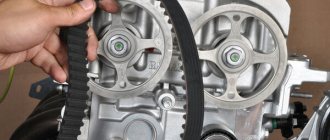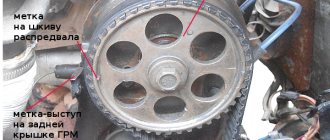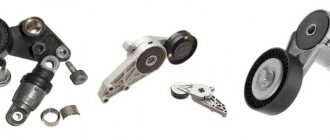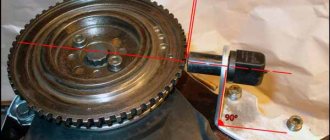We pull and pull, but we can’t pull it out
We continue the “Auto Service” section and our acquaintance with small and not so small enterprises in this area. This time the main place of action is the Central district of Tolyatti, since a month earlier we “washed ourselves off” at the service station in the Auto diagnostics-injectors. And the reason for visiting at first glance is not so serious - all that was required was to tighten the timing belt of the VAZ-2112 engine, which, in our opinion (or according to an invented legend), had weakened after its recent replacement. However, this was not idle curiosity. We experienced the results of a broken belt on our own pocket, which immediately relieved us by 4.5 thousand rubles needed to replace bent engine valves (see “SV” No. 41, page 10). It should be noted that it is from this amount and upwards that the loss of funds by the car owner begins to count in the event of a given breakdown. And the integrity of the timing belt depends not least on whether it is tensioned correctly.
The main measuring tool is the finger
Ideally, to check the timing belt tension on a sixteen-valve VAZ engine, you need to use a special electronic frequency meter (as written in the Maintenance and Operation Manual). But, as it turned out, this device is almost mythical. Looking ahead, let's say that we were not able to see it at any of the service stations, and even experienced engine mechanics can only guess what the device looks like. However, in the same manual, the manual verification method is described in detail. It involves checking the tension of the toothed belt in the middle part of the branch between the camshaft pulleys. It should be such that under the action of an object 3 mm wide with a force of 10 kg, the belt deflection is 5.4 mm. Deviations in any direction are allowed no more than 0.2 mm. The engine must be at “room” temperature (+15-30°C). An overtightened belt breaks - the strength of the cord threads is limited. And the tighter the belt is, the faster the threads will break. A loose belt will also not last long, because... when entering the pulley, the belt teeth do not fall into the cavities of the pulley teeth - undercutting occurs and the subsequent separation of the teeth from the base. Again, looking ahead, I would like to say that none of the masters bothers themselves with any measurements. They trust their finger. Like, experience brought to automaticity. Meanwhile, according to scientific research, to bring any action to automaticity, 300-400 repetitions of this action are required. Therefore, all this seems doubtful. We armed ourselves with the required object 3 mm wide, stocked up with a ten-kilogram weight, a tool, and to control the deflection of the belt we used a caliper, providing a measurement accuracy of 0.05 mm. To carry out the control procedure, it was necessary to unscrew 4 nuts securing the plastic screen of the receiver (the one on which “LADA 16 valve” is written) and 5 bolts securing the timing belt protective cover. A five-minute job. Measurements on our car showed a belt deflection of 8.1 mm on a cold engine. Clearly needs a lift. With this tension, when the engine speed changed for 1 - 2 seconds, the belt resonated and pulled out the protective casing. This could be observed through a viewing window in the casing. It's also a mess. Then, naturally, we pretended to be “dummies” and hit the road.
Going to service stations
At the first service station you come across, “half the car needs to be disassembled.” Smells like a scam. It also turned out that the car needs to be washed before entering the station. There was a line at the car wash, so we went to the Grand. A friendly young man checked the belt tension and assured us that it was “normal” and there was no need to worry. By the way, the same diagnosis was made for our belt at two more service stations (the Forsazh service station, located on Komsomolskaya Street in the area of the roundabout with Larina Street, and the Balem service station in the Plamya GSK) out of sixteen that we visited. But we know that this is not so. At one of these stations we were even told with authority that the belt needed to be loosened; at another they assured us that deflection was allowed up to one centimeter. You can't hear enough. Some insisted that the pump was howling, others that it was the rollers. Once again you are convinced: how many people, so many opinions. Although in fairness it should be noted that the repairmen at these three stations are honest and good people who really care about what happens to your car after the repair, and they don’t just take money. But at more than 50% of the auto repair shops that we visited, the masters generally refused to help us for no apparent reason. One case is indicative: they drove up to the car service building on Novo Street and asked people who could tighten their belts. The people answered that it was Petya. Petya himself was playing cards at this time. Question: “Peter, can you tighten the belt on the “twelfth”?” — found him with a map raised above his head. Frozen, without looking in our direction and without lowering his hand with the map, he asked with hope in his voice: “Generator?” Hearing in response “GRM”, Peter disappointedly threw a card onto the gaming table, at the same time saying: “Well, screw it...!” For foreigners, the word at the end of his short phrase could be described as “untranslatable vernacular.” It turns out that our auto repair workers don’t like modern engines. And they are afraid. They are afraid that if after their work the belt unexpectedly breaks, then the car owner’s claims will be directed at them. So finding someone who would tighten the belt is a real problem. But in our search for such a person, we were lucky enough to stumble upon a car repair establishment, whose name can be safely nominated for the Mikhail Zadornov Prize: “Trade and service car service “Start”. True, we were not able to “check out the auto service” at “Start” for the reason described above.
Money down the drain
We had the timing belt tightened at the Prestige service station, which is located on Komsomolskaya Street, 86. The mechanic agreed to do the job without hesitation. He immediately began to unscrew the bolts and nuts, remove the covers and tighten the belt. Such zeal is very commendable, but he did not even check how the belt was tensioned before. Didn't even touch it. This is explained by one simple reason: he just makes money and doesn’t care what he does, as long as the client pays. For 15 minutes of work 100 rubles. We instrumentally evaluate his work after the work is completed: the belt deflection is 8.2 mm. Even weaker than before. As a result, the money was wasted. It seems that with such an attitude towards work, a “prestigious” minder does not have regular clients. We began to despair. We've been driving around the city for two days now, visiting fifteen service stations. Is it really possible that no one will tighten the belt as it should be? And quite by chance we stopped at the Sasha service station, based on Dzerzhinsky Street opposite the 4th block. A sign above a small box read: “All types of work.” The repairman Sasha, or maybe not Sasha, maybe Sergei, carefully and slowly did the work, plus he also tightened the throttle valve drive, although no one asked him to do this. Moreover, he also lubricated the bolts securing the protective casing with grease. Apparently, his conscience did not allow him to charge “a hundred” for tensioning the belt, but with additional work - please. After Sasha’s adjustment, the belt even subjectively began to bend less. We apply 10 kg, measure the deflection and - lo and behold! — we get 5.6 mm (according to the factory instructions, this is the extreme degree of “looseness” of the belt). We don’t know how “Sasha” did what he did, but it’s an excellent result. And if this is not a “finger in the sky”, but sensitive hands and excellent knowledge of the engine, then honor and praise to him. For the rest of the mechanics, I would like to advise them to invent some kind of device that allows them to tension the timing belt according to the requirements of the manufacturer.
To avoid excruciating pain later:
*In the recent past, AVTOVAZ, as a manufacturer, determined the service life of a timing belt at 60 thousand kilometers. Now this figure has been reduced to 45. * The belt must not be bent. If at the time of purchase there is a suspicion that the belt was bent during storage and transportation, then it is better to refuse the purchase. This one won't last long. * The belt must be clean during operation. Do not allow oil, antifreeze or dirt to come into contact with it. For example, oil corrodes rubber, and dirt is an abrasive. Cracks are not allowed on the belt. * Do not remove any parts of the timing cover. Any small stone caught in the drive will immediately cause the belt to break. * When replacing a belt, it is advisable to replace the support roller and tensioner roller for the reason that worn-out roller bearings may begin to jam, which will lead to overheating of the belt and the appearance of cracks on it.
The timing belt, or timing belt for short, is the connecting element between the camshaft and the crankshaft. As stated in the instructions supplied with the car, replacing the timing belt is strictly regulated. In addition to replacement, the timing belt must be periodically checked throughout its service life, not only for external damage, but also for tension. A loose or too tight timing belt can cause a lot of trouble for the car owner.
The tension of the timing belt must be checked when replacing the belt itself, after work related to removing the belt, and periodically throughout its entire service life.
Checking the tension of the timing belt is simple, does not take much time and can be done by almost every car owner. Checking the timing belt tension is done using your hands; to check the tension, you need to turn the timing belt with two fingers on the longest section. If the timing belt turns with difficulty by about 70-90 degrees, it means that it is properly tensioned.
When the belt turns too easily or vice versa, this cannot be done. This indicates incorrect adjustment of the timing belt. The first case means that the belt is loose, and the second that it is too tight. In any of these cases, immediate adjustment of the timing belt is required, otherwise this can lead to serious consequences for the car and significant financial costs for the car owner.
Important! A correctly tensioned timing belt fluctuates within 1 centimeter from its own axis.
There is another way to check the timing belt tension. To use this method, you will need a hand-held spring scale and a caliper. Having acquired everything you need, you need to hook the hand scales in the middle between the camshaft pulleys and pull the scales to the 10 kilogram mark. Having reached the required mark, you need to measure the deviation from the standard position of the belt with a caliper; it should be 5.5+ - 0.2 millimeters.
timing belt tension standards
- The normal tension of the timing belt is considered to be the maximum point of rotation of the belt by 90 degrees with a force of 2 kilograms or 19.6 newtons.
- The deviation when exposed to 10 kilograms is 5.5 millimeters.
Tools to help you tension the timing belt
To adjust the timing belt tension we need:
- Special key for adjusting the timing belt. If it is missing, you can use two nails and a screwdriver or make a similar key from a steel fork;
- Standard set of keys.
Interesting! If there is no special key for adjusting the timing belt, you can make it yourself from a regular steel fork. To do this, you need to break off the two central teeth, shorten the side ones a little and bend them.
Tensioning the timing belt with your own hands, work progress step by step
Having acquired everything you need, you can proceed directly to tensioning the timing belt:
- Open the hood of the car;
- Remove the protective shield from the timing belt;
- Loosen the nut that secures the tension roller;
- Using a special wrench, we adjust the tension roller itself. Clockwise loosens the timing belt, and counterclockwise tightens it accordingly;
- After adjustment, having fixed the roller in the required position, you need to tighten the nut securing the tension roller directly;
- Checking the timing belt tension;
- If the belt is adjusted correctly, install the protective shield in its place.
Belt tension on 16-valve VAZ engines
Tensioning the timing belt on Priora and other cars equipped with 16-valve engines is generally done in the same way.
However, there are slight differences. Thus, the gas distribution mechanism cover of these engines is mounted on 6, and not on 3 bolts, as in the previous case.
In addition, the timing belt on VAZ-2112 power units (16 valves) is tensioned using two rollers. One of them is movable, used for tension. The second one is the support one. » alt=»»> When tensioning the belt of a “Prior” motor or motor 2112, special care must be taken. After putting it on and tightening it, you must definitely try to crank the engine by hand.
If the crankshaft cannot be turned, you should once again check that the marks are installed correctly. On these engines, an error almost always leads to damage to the valves and piston group.
Replacing the timing belt, work progress step by step
To replace the timing belt we will need:
- Standard set of keys;
- Special key for adjusting the timing belt;
- Tool for checking timing belt tension;
- Directly new timing belt.
Replacing the timing belt with your own hands should only be done by people with sufficient experience and knowledge. Incorrect installation of the timing belt will certainly lead to additional financial costs.
Having prepared everything you need, you can proceed directly to replacing the timing belt:
- Open the hood;
- Remove the timing belt protective shield;
- Using the pulley mounting bolt, use a wrench to turn the timing belt so that the piston of the first cylinder is at top dead center on the compression stroke. To do this, you need to place marks on the camshaft timing belt pulley and the timing cover opposite each other.
- By setting the piston of the first cylinder to the required position. Using a screwdriver, fix the crankshaft in the required position. To do this, it must be inserted between the flywheel teeth in the clutch housing;
- Now remove the generator drive pulley. To do this, unscrew the bolt that secures it;
- Loosen the tension roller and turn it to loosen the timing belt as much as possible;
- Remove the old timing belt;
- We put a fresh timing belt on the crankshaft pulley, and then on the pump pulley;
- We install a fresh timing belt directly behind the tension roller;
- We put a fresh timing belt on the camshaft pulley;
- Now we adjust the timing belt tension, as described above;
- We put the timing belt protective shield in its place.
- Experienced specialists recommend checking the timing belt tension every 13-15 thousand kilometers. A broken timing belt can bend the valves; according to statistics, this happens in 87% of cases.
- Under no circumstances should you operate a vehicle with a worn or incorrectly tensioned timing belt. Replacing or adjusting a timing belt costs several times less than the consequences of its breakage.
- Too much tension on the timing belt increases wear on the belt itself, as well as the rollers and bearings several times over. A loose timing belt can jump, bending the valves and also tearing the belt itself, which leads to significant financial costs.
- If the timing belt is overtightened, a squealing noise can be clearly heard while driving.
- Do not allow any lubricants to come into contact with the timing belt - this will significantly reduce its service life.
- When replacing the timing belt, it is also necessary to carefully inspect all the rollers. According to experts, it is imperative that all rollers be replaced after every even numbered timing belt replacement, that is, every second timing belt replacement we also change the rollers.
How to tension the timing belt?
Timing mechanism - gas distribution mechanism. This device allows you to synchronize the operation of the crankshaft and camshaft. In fact, if the timing belt, which is responsible for synchronization, breaks, the car will not go anywhere. Our article will tell you how to tighten the timing belt if it is loose and the car engine does not give the required speed.
How does the belt work?
The design and method of operation of this automotive consumable is quite simple. In short, a track belt is simply a long rubber band that is attached to both the crankshaft pulley and the rollers of all the engine components that need to be driven.
When the engine crankshaft rotates, it also drives the reel belt, which in turn drives the air conditioner, alternator, water pump, cooling fan, hydraulic steering, etc.
Another way to tighten the timing belt
Some craftsmen also use another method for properly tensioning the belt. First you need to find a dynamometer. This device allows you to evaluate the force of pressure, and in our case, tension. Now, by eye, set the desired degree of tension, as you think, and tighten the tightening roller nut. Hook the dynamometer onto the belt and pull it towards you. On the scoreboard you will see the resulting indicator. The standard for tensioning the timing belt is 2 kgf. Based on the data from the measuring device, you can change the tension up or down. Using this trial and error method, you can achieve perfect operation of the device.
In addition, many experts advise monitoring the lubrication level of timing mechanisms. A large amount of it or any liquid that gets on the belt can cause it to simply jump out of the entire system. But a belt break occurs precisely due to the lack of the required amount of oil in the engine systems or due to its overheating.
On many modern internal combustion engines, the timing belt is tensioned automatically; the mechanic only needs to fix the position of the tensioner roller. But there are also quite a few power plants where the belt is tensioned with manual checking. As a rule, the hands of an experienced craftsman cope with this task with a bang. It will be much more difficult for a beginner to do this. In this article we will try to provide recommendations and advice that will greatly facilitate the task of diagnosing the tension of the timing rubber ring.
How to tension the timing belt. Correct timing belt tension on Kalina, and not only
There is no need to explain to anyone who understands at least something about cars how important it is to tension the timing belt correctly.
Impacts on the casing when the timing belt tension is weak is the most harmless thing. Next, the belt can jump over the teeth, and this entails a violation of the valve timing. Significant jumping of the timing belt over the teeth can sometimes lead to almost the same disastrous consequences for the engine as a complete break. That is why the closest attention should be paid to the correct tension of the timing belt when replacing it.
How to tighten the belt on Kalina
Let's look at the correct tension of the timing belt using the Lada Kalina engine as an example.
So, before tensioning the timing belt, we turn off the engine after idling in neutral gear. But in this case the crankshaft does not stop at will, but only in those positions in which the forces acting on it are balanced.
Our task is to ensure uniform rotation of the crankshaft with minimal resistance before tensioning the timing belt.
1. Unscrew the spark plugs: the compression in the cylinders due to the tension of the timing belt is eliminated.
2. We get rid of the influence of the spring force on the timing belt tension: we hang up one of the driving wheels of the car, engage the highest gear and rotate the wheel by hand. A position in which there is almost no resistance to rotation means that the spring forces are in balance - exactly what we want.
3.Now we turn off the gear, and you can proceed directly to tensioning the timing belt.
I adjust the tension of the timing belt not by eye, but using a basic dynamometer and a simple hand-made wrench (see picture).
At a distance of 100mm, a recess is made on the shoulder of the key, to which we hook the hook of the dynamometer. The correct tension of the timing belt corresponds to a force of 2 kGs.
Having achieved this force, we press the curved part of the key against the end of the camshaft pulley bolt and hold it in this position. Tighten the tension roller nut.
All. We managed to tension the timing belt perfectly.
znay-i-umey.ru
VAZ "Ten"
A popular car equipped with an engine with a timing belt drive. The manufacturer recommends replacing the rubber band of the GRS mechanism after 40-45 thousand kilometers, but diagnostics cannot be neglected before this period. The principle of “installing a new belt and forgetting about it” must be eradicated, understanding that being guided by this rule will not lead to anything good.
ATTENTION! A completely simple way to reduce fuel consumption has been found! Don't believe me? An auto mechanic with 15 years of experience also didn’t believe it until he tried it. And now he saves 35,000 rubles a year on gasoline!
Attention. It is very important to regularly diagnose the technical condition of the belt and its tension.
In order to check the tension today, special electronic devices are used, although you can do without them. Only on the timing rubber product itself there should not be a drop of oil, dirt or signs of tear. Everything must be almost perfectly clean, without delamination, for the diagnosis to be most effective. Otherwise, it is better not to bother with diagnostics, but to immediately replace the belt with a new one, eliminating the reason why it was worn out or lubricant got on it.
Another important condition: the check must be carried out on a cold internal combustion engine.
The checking and adjustment process itself is as follows:
- The scales are fixed by the handle of the key. You can attach them with electrical tape to the socket wrench so that the hook of the scale is not at the bottom, but on top of the wrench. In other words, you need to do everything so that the measurement is carried out when pressing.
- Now you should remove the front belt protection cover.
- The front wheel of the V8 will have to be jacked up, and then the right mudguard of the engine compartment will have to be removed.
- Using a 17M wrench, turn the crankshaft by the bolt and carefully inspect the belt for defects.
Now directly about the diagnostic process:
- First, the compliance of the tension in the middle of the product is checked, where the belt sits between the camshaft sprockets. A long pin is placed on the belt and pressed on top using a tool obtained from a steelyard and a key. The pressing force should be 10 kg. At the same time, use a caliper to measure the sag relative to the installed pin.
Attention. If the tension is accurate, the deflection should be 5.4 mm. Otherwise, adjustments will have to be made. If the value is less, then the tension is too strong; if it is more, the belt is too loose.
The adjustment is carried out as follows:
- The nut securing the tensioner roller (17M) is loosened.
- The roller is tensioned or loosened.
- The nut is tightened back into the intended position.
Note. The nut should be fixed so that the roller does not move and cannot be released.
It is also important to remember that excessive tension on the rubber timing ring reduces its service life and can easily lead to failure of the tensioner roller and even the pump. You should not listen to those false masters who claim that strong tension will supposedly eliminate all problems with the belt.
Weak tension always means the belt jumps over the teeth of the camshaft sprocket, which inevitably leads to disruption of the phases of the hydraulic valve mechanism. On the contrary, a strong tension is wear by the bearing of the same roller or water pump, as well as direct wear of the belt.
The tension can also be checked using a special device, such as “Contiteg”. The principle of its operation is quite simple, you just need to measure the amplitude of the belt vibrations.
Everything is done like this:
- The “Contiteg” device is brought to the belt.
- You need to click on the belt with your finger.
- Check the amplitude readings with the tabular data.
The device always comes with a detailed description of its operation in a case. It consists of a device with readings, as well as a sensor, which must be brought to the belt (at a distance of 1 cm).
Attention. It is extremely important that the sensor “overlaps” the belt with only half its length.
When is it necessary to replace the timing belt and set the marks?
Without exaggeration, a worn timing belt can be called a “ticking time bomb.”
The importance of this element in the car system is difficult to overestimate. Usually it is made of high-quality rubber, the service life of which is designed for 50-60 thousand kilometers.
But, if the vehicle is operated in unfavorable conditions, the replacement interval will be different.
Replacing a belt and pump is a labor- and financially expensive process. But all the work will cost much less than repairing a failed engine due to a broken gear mechanism. In no case should you save money and put off scheduled car maintenance “for later.”
In most cases, the replacement interval is indicated by the manufacturer in the documentation for the vehicle. In addition to the resource built into the belt, it is worth considering the following factors that shorten the service life of the rubber element:
- Engine oil getting on the surface of the timing belt
- Leakage of the front crankshaft oil seal
- Tension roller malfunction
- Pump jamming
As you can see, there can be a sufficient number of breakdowns in the car system that directly affect the service life of the belt. If the scheduled replacement time has come, or its resource has been prematurely exhausted, it is not enough to simply replace the old mechanism with a new one - you also need to take care of the correct installation. To successfully do all the work, it is enough to arm yourself with the necessary tools and know how to align the belt with the marks.
Audi 100
In general, Audi modernized almost all engines in 1991. Thanks to it, the optimal power values have shifted in the direction of cutting speed. Thus, this directly affected the nature of the tension of the rubber timing ring.
You should know that initially the belt on the Audi was tensioned using a pump. This was actually done only once, and then when replacing, a new belt was installed without any adjustments.
After modernization, instead of a stationary roller, a movable one equipped with a temperature compensation system was installed. This roller assembly was supplied assembled and cost about $130, but the owners rarely used the original ones and installed duplicates for $20 in order to save money when replacing them. But as a result of this, some Audi owners began to have problems; the belt periodically shifted and slipped out of place.
The task of adjusting the Audi timing belt comes down to ensuring that the belt can be twisted 90*, or in other words, one quarter of a full turn. Below are instructions on what and how to do if the tension is too strong or too weak.
- The thermal roller is tested only when cold.
- Initially, the belt tension should be 0.
Let's continue:
- Using a caliper, set the distance between the roller lock and its rotator (let’s call it “A”). It should be equal to 49 mm.
- After this, you need to start the internal combustion engine, but immediately turn it off as soon as the fan turns on.
- Now check distance “A” again. Changes should not be less/more than 7.2-7.3 mm.
Attention. If distance “A” is less than the above values, the roller should be replaced. The thermal roller performs several functions on Audi. Depending on the temperature of the internal combustion engine, the device changes the belt tension. You should know that when the motor gets very hot, the tension is automatically weakened.
This thermal device lasts for approximately 150 thousand miles, but there are exceptions.
Which timing belt to choose for replacement
According to statistics, domestic car owners, when choosing auto parts for their cars, prefer brands such as Limforder, Contitech, Gates, Dayco, Balakovo or Bosch.
To avoid being scammed, you should buy a timing belt from a certified seller or an official car service center. In these cases, the spare part may cost a little more, but there will be a guarantee of the quality and reliability of the product.
- Gates
Gates is the most popular brand for the production of timing belts for internal combustion engines. The company's production facilities are located in Belgium. It produces products not only for cars, but also for other equipment used in other areas.
In fairness, it is worth noting that products of this brand are rarely found on the secondary market of auto components. This is explained by the fact that Gates is a partner of leading automotive concerns. You can buy parts of this brand only at official service centers or by ordering them from the factory. The products of the Belgian manufacturer are expensive, but this is more than compensated by the guaranteed quality and reliability.
- Lemforder
This brand is the largest manufacturer of components for motor vehicles in Germany. Limforder products are found in various price categories. The timing belts of this brand are highly reliable, but recently you can buy German or Korean spare parts with this logo.
- Bosch
The most famous company in Germany for the production of spare parts for cars was founded in the 19th century.
Timing belts with the Bosch logo perfectly combine cost and quality. It is noteworthy that this brand produces belts for a wide range of car models. On the Russian market, counterfeit Bosch spare parts are quite rare. German timing belts also have their drawback - after installing them, it takes some time to grind the product into the pulley profile.
- Balakovo
In addition to timing belts, the Russian company produces a wide range of chemicals and rubber technical products.
Experts believe that the quality of products from domestic manufacturers is not inferior to imported analogues. Buyers are attracted by the affordable cost of components produced under the Balakovo brand.
- Dayco
Counterfeits of products from an American manufacturer of automotive components are often found on the Russian market. This is why there are numerous negative reviews about the Dayco brand on the Internet. The attractiveness of American-made timing belts lies in their average price and good quality. The brand's catalog contains a wide selection of spare parts for different car models.
- Contitech
The German company produces components for new models of leading automakers. Many concerns that produce cars cooperate with this brand and the cost of its products is quite high. Contitech timing belts are characterized by reliability and long service life. The disadvantages of some products include the need for grinding into the groove profile.
Volkswagen
As you know, Volkswagen cars are equipped with timing belts and chains. According to the service book, the belt tension should be carried out so that one branch of the belt can be rotated 90*, as is the case with the Audi. Only here a few questions arise.
For example, one of them concerns the rotation force of the belt. Some people have strong fingers, others have weak ones. For this reason, it is recommended to carry out a combined tension and take the average value. More details below:
- Do not tension the belt too much, and in this case, when the engine is accelerating, the belt will slam noticeably.
- Pull the belt tightly, and then the belt, together with the tensioner roller and the pump, will make a characteristic unpleasant sound.
You should push off from the golden mean, when the belt does not clap or make noise.
Kia
On Kia cars, you first need to figure out where the belt is. Depending on the specific Kia model, the belt may be shaped like a semicircle or come out as a tensioner bolt.
- The mark on the crankshaft pulley must match the mark on the cylinder head cover.
- When adjusting the tension, be sure to use the correct size wrench.
Tension is carried out by turning the bolt with a wrench in the opposite direction. If the tension is incorrect, the internal combustion engine will not function properly. And if it starts to whistle and make unusual noise, this is a clear indication of insufficient tension.
In most modern cars you can find a timing belt tensioner pulley. It is necessary to ensure the normal functioning of the internal combustion engine. The designs of the rollers can be different, everything depends on the type of adjustment - manual or automatic. The operating principle of these devices will also differ, and significantly.
Why does the belt need to be tensioned?
Because it operates under high voltage, over time the tire that makes up the belt begins to relax and stretch slightly. And when it stretches, problems begin with engine components, because without belt drive they cannot perform their functions.
A loose coil belt can not only jeopardize the performance of engine components, but it can also cause internal damage to the engine itself, and then you will have to completely rebuild your car's engine or, worse, buy a new vehicle.
How can you tell if a track belt is stretched?
Look at the warning light on your car's dashboard - most modern cars have a warning light that shows the battery voltage when you start the engine. If the belt is not tight, it will not be able to rotate the alternator pulley, causing a drop in electrical current to the car's engine, which in turn will cause the warning light on the dashboard to turn on. Attention! The light may be on not because of belt tension, but because of problems with the battery or alternator.
Pay attention to engine temperature - if the timing belt is too tight, it may not supply enough water to the water pump and this will cause the engine temperature to rise, which will not be able to cool effectively. Listen for unusual noises or squeaks in the engine area - Squeaks are one of the first signs that the belt is loose, and if you hear them when you start the car when the engine is cold, or hear them when accelerating, then it's time to think about tightening the belt.










